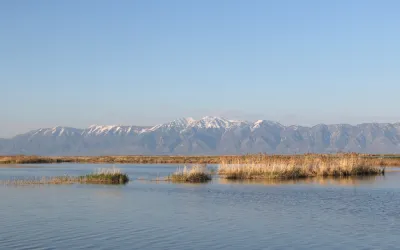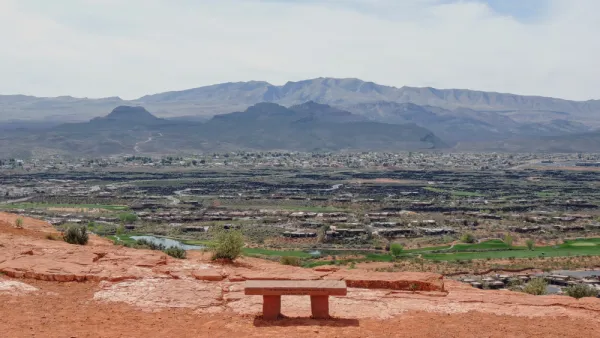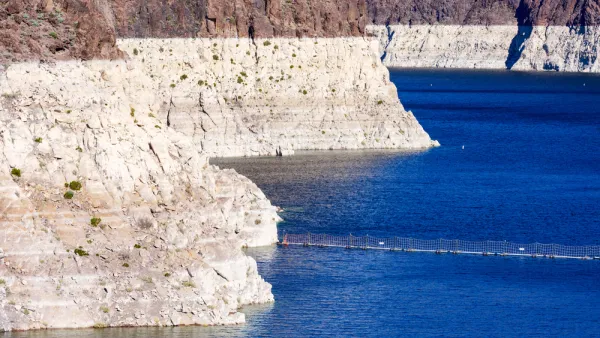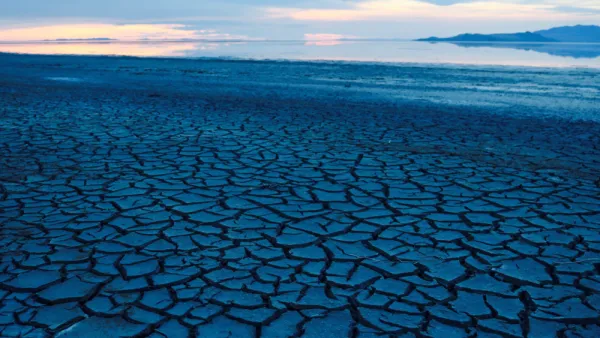The state's widespread practice of supplying unlimited untreated water to homes may be part of the reason it has to spend billions on a new pipeline and dam.

Compared to other states, Utah is among the driest, among the thirstiest, and among the fastest-growing; it's also the only state that provides, to a significant number of residential properties, "untreated agricultural water from canals, sold at an unmetered flat rate, to irrigate their lawns, gardens and landscaping."
It's called "secondary water," writes Matt Weiser at Water Deeply, and the practice stems from the unusual way that water rights in Utah developed as agricultural land gave way to residential construction.
"In nearly every other community in the nation, when farms were converted to housing the irrigation water was usually sold to other farms or allowed to remain in-stream. And new homes used treated drinking water for outdoor irrigation as well as in their kitchens and baths – all measured and billed according to a single meter at the curb."
But in Utah, 61 percent of urban water suppliers allow unlimited secondary water use, usually for $10 to $15 dollar per month.
Without meters, it's more or less impossible to obtain definitive statistics on water use in Utah, but one study did show residents of Salt Lake County—which does not supply secondary water—used 78 percent less water than residents of two neighboring counties.
Recently, the unbridled use of secondary water has been the target of criticism as Utah debates two enormous, expensive water projects. The first is a dam on the Bear River, which is the most significant tributary to the shrinking Great Salt Lake; the other is a pipeline from Lake Powell, a reservoir that has challenges of its own.
Some conservationists and fiscal conservatives would rather see the state try to reduce water use first, but both groups expect resistance. Weiser speaks to the state senator who recently introduced a bill to require meters on secondary water supplies across the entire state; the politician succinctly comments, “I can tell you right now, the cities are not going to like that.
FULL STORY: Utah, America’s Thirstiest State, Wrestles With Unmetered Water Use

National Parks Layoffs Will Cause Communities to Lose Billions
Thousands of essential park workers were laid off this week, just before the busy spring break season.

Retro-silient?: America’s First “Eco-burb,” The Woodlands Turns 50
A master-planned community north of Houston offers lessons on green infrastructure and resilient design, but falls short of its founder’s lofty affordability and walkability goals.

Delivering for America Plan Will Downgrade Mail Service in at Least 49.5 Percent of Zip Codes
Republican and Democrat lawmakers criticize the plan for its disproportionate negative impact on rural communities.

Test News Post 1
This is a summary

Test News Headline 46
Test for the image on the front page.

Balancing Bombs and Butterflies: How the National Guard Protects a Rare Species
The National Guard at Fort Indiantown Gap uses GIS technology and land management strategies to balance military training with conservation efforts, ensuring the survival of the rare eastern regal fritillary butterfly.
Urban Design for Planners 1: Software Tools
This six-course series explores essential urban design concepts using open source software and equips planners with the tools they need to participate fully in the urban design process.
Planning for Universal Design
Learn the tools for implementing Universal Design in planning regulations.
EMC Planning Group, Inc.
Planetizen
Planetizen
Mpact (formerly Rail~Volution)
Great Falls Development Authority, Inc.
HUDs Office of Policy Development and Research
NYU Wagner Graduate School of Public Service





























